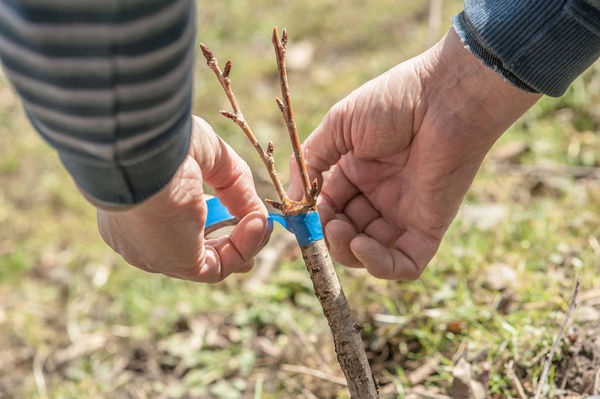Plum - one of the most popular fruit treesknown to summer residents of almost all regions of Russia.
This stone fruit has a great variety of varieties and is the leader in the number of species among all fruit trees. Yellow, red, blue, large or smaller plum, it pleases with its rich crops, attracting more and more people who want to plant such a tree on their land.
There are effective ways to propagate the plum yourself. and grow a great harvest on this tree. Plum is very susceptible to reproduction: it is easily rooted, gives rise to shoots, it has quite high adaptive properties.
Consider artificial (grafting, grafting) and natural (root shoots, seeds) plum breeding methods.
Table of contents
Reproduction green cuttings
This method of breeding plum is most common for dark varieties.
The soil is prepared in advance for planting a green cutting - a mixture of peat and sand will create an optimal microclimate, before direct planting you need good soil moisture and fertilizer (for example, superphosphate - 1 tsp to 10 liters of water).
On the uterine tree shoots are selected, which will be cut off - solid and acquiring varietal reddish tint.
After the preparatory work cuttings are planted in the ground about 3 cm deep (without closing the bottom sheet), the distance between the landings is 7x7 cm.
Experienced gardeners recommend creating a good microclimate for planting cuttings - several times a day gently moisten the soil, cover planting film, making sure that the temperature under it does not rise above 30˚С.
After 15-20 days, the film can be removed, during which time the first roots should appear and the plants will need airing and oxygen.
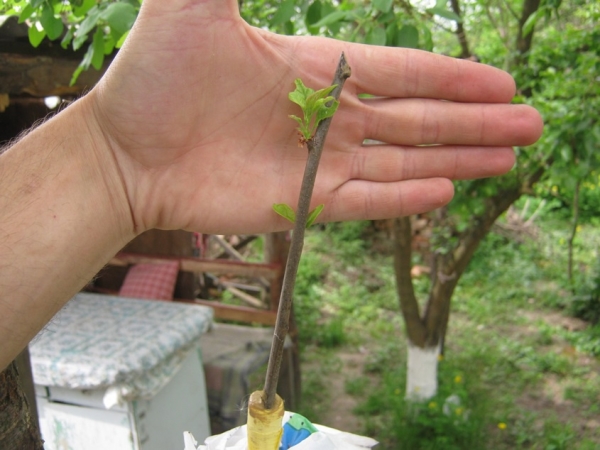
The timing of propagation by cuttings determines the success of the result. Cuttings are cut in the middle of summer, preferably in the early morning or evening, in the process of germination it is important to them the absence of excessive heat and cold, for which the greenhouse film is installed.
For winter, it is recommended to sprinkle with peat cuttings or fallen leaves to avoid frostbite of young roots.
How to root green cuttings:
How to propagate root shoots?
Universal is the method of reproduction of plums from root shoots.which is recommended to cleanas it takes away the fruiting forces of the mother tree.
A small young shoot (up to 50 cm in height) from this growth can be a material for planting. The shoot should grow at a distance of about 1 m from the main tree, be well developed, not affected by insects.
When choosing a developed root system is important, which will allow the escape to take root easily in a new place.
The shoot is neatly separated from the main roots of the mother plum., the root pruning place is covered with ash. The separated shoot is placed in a well-moistened soil, in a shady place where it will adapt to new conditions - independent growth.
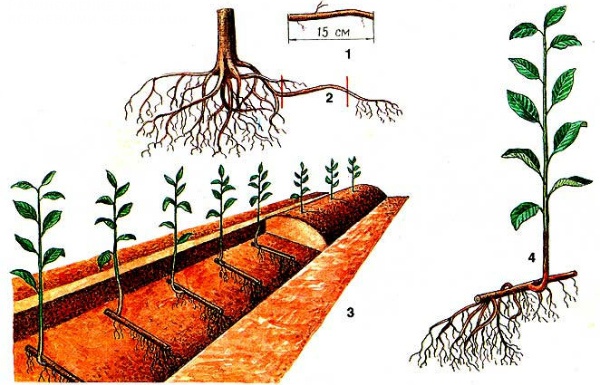
Its top pinch. As a rule, in a month fresh leaflets will appear on it - this means that the rooting process was successful.
Plum is an unpretentious plant that can reproduce by root shoots and independently adapt, which only confirms this. but young seedlings need good care and timely fertilizer.
One month after transplanting shoots plum required the first feed - saltpeter, azofoskoy, infusion of nettle or cow manure, which are bred in water. Feed can be carried out every two weeks, so that the plant is strong.
Grow a plum seed? Maybe!
Propagation of plum seeds is also often used. gardeners. In this case, preservation of varietal properties is unlikely, special observations of the seedlings, control and selection of the best are required here, only then will a varietal plum be obtained.
You may be interested in our publications:
For planting seeds it is necessary to prepare planting material. Well-known breeder V.N. Shalamov writes that the fruit from which the bones are taken must be perfectly mature, after removal, it is left to the limit of lying, only then bones are taken from it.
They are freed from the pulp, washed and dried under natural conditions, avoiding sunlight. Dried seeds are transferred to a plastic bag, closed and stored until autumn or spring planting at room temperature.
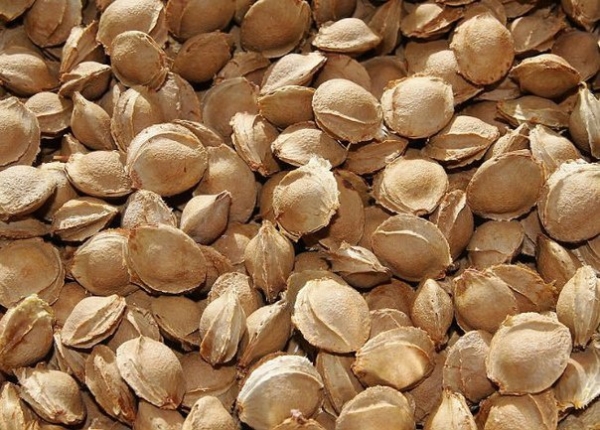
The process of ripening seed in plums of different varieties occurs up to 180 daysMany breeders offer to mix selected plum stones with wet sand during this period and store them in a refrigerator or a special box dug into the ground and protected from water, insects and rodents.
After such storage, many seeds hatch, which means the results of planting will be more successful.
Planting of prepared seeds occurs in spring or autumn., in a well prepared and fertilized soil (VN Shalamov recommends fertilizing 1 sq. m of planting bed with a mixture of humus (4-6 kg), superphosphate (70 g), potassium salt (30 g), ammonium nitrate (30 g) and lime (50-90 g).
Seeds stacked in the ground at a depth of 2-3 cm, down the spine or the place from which the spine should appear, the distance between the seeds is 30x10 cm. The seeds are covered with fertile soil.
During the entire period of growth, the land should be freed from weeds, moisturized and burst of breath, and pest damage is carefully avoided. After 1-2 years, the selected seedlings can be transplanted to a permanent place..
Criteria of viability and future yield is how the seedling grew during one season. The better the growth, the higher the winter hardiness and vitality.
Grafting as a way to save varietal species
This method is the most successful. for preservation of high-quality plum qualities. Stock, i.e. the basis on which the vaccination is carried out is usually grown from seed, less often from root shoots.
At summing up, extra leaves and branches are removed in advance., it is poured abundantly to activate sap flow. The age of the stock should not exceed one year, it is desirable that its mother tree was a winter-hardy plum.
Privoem can be a kidney or cutting, each has its own methods of grafting.
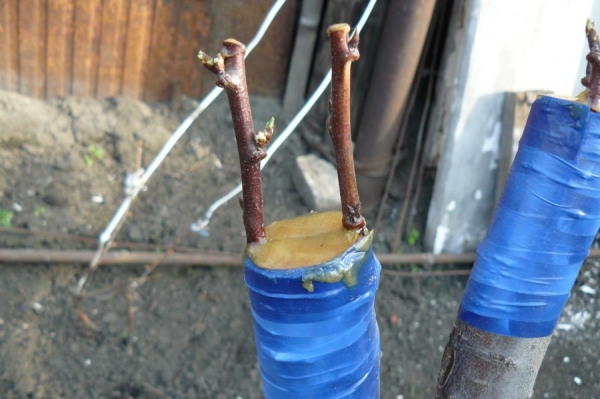
Vaccination by the kidney is called an oculum.. A special budding knife from a high-quality tree cuts a kidney - a strip of bark about 3 cm and about 0.5 cm thick with a strongly developed kidney.At the stock at a level of about 4 cm from the soil, an incision is made, where, carefully bending the bark, a shield with a bud is inserted.
Budding can be done in another way, when the graft is cut with a wedge with a thorn up to 15 cm above the kidney, which is inserted under the prepared tongue on the stock. In this case, it is recommended to vaccinate two buds on one stock at a distance of about 4 cm and 11 cm from the soil in order to increase the success of the vaccination.
Place budding neatly tied with polyethylene, leaving open only the kidney. The harness is removed after 3 weeks after vaccination.
Vaccination cuttings has a longer preparation. Cuttings are harvested in advance and stored during the autumn-winter season and are grafted in two ways: in cleft or in bark.
Cleft involvesthat the stock and graft are about the same thickness, but this is not a prerequisite. The stock is cut horizontally and a vertical split is made in the center with a depth of no more than 3 cm (if the stock is a stump left over from an old plum, then the depth does not exceed 7 cm).
The cutting should be cut so that there are 4-5 eyes above the place of the intended alignment.The lower part of the cutting is cut with a wedge similar to the stock (no more than 3 cm for a young stock). When in contact, the graft and the stock should be pressed tightly against each other.
Vaccination for the bark is carried out only with active sap flow, then the bark easily moves away from the stock. It is carefully cut, if you plan to plant several cuttings at the same time, then in several places.
The cutting is cut diagonally and connected to the stock. The joint should be tight, it is desirable for the wood layers to come together.
After connecting the cutting with the stock, the grafting site is tightly tied with polyethylene, electrical tape or a special elastic tape. The remaining open spaces are thickly covered with garden pitch.
Before the first leaflets, it is desirable to protect the vaccination from moisture, excess solar heat - the vaccination site is shaded and covered with a transparent bag.

Plant in autumn, spring or summer: seasonal features
Faced with the issue of plum breeding, many are wondering about the best time for him. Summer heat, like the beginning of spring and autumn in different climatic zones has its limits. This most important factor should be taken into account when determining the time for reproduction.
It is also important that reproduction of plum can have a fairly long preparatory stageFor example, if seed preparation or storage of root growths or cuttings occurs. All of them, as a rule, are collected in the summer-autumn period and persist until spring.
Reproduction of fruit trees:
Each seasonal propagation of plums has its own seasonal terms:
- autumn and spring planting of root shoots creates favorable conditions for the development of plums. Autumn planting is carried out under frosts (October), spring is recommended immediately after the main water gathering (April-early May);
- vaccination is always carried out in the summer, in the period of the greatest sap flow of plants, during this period there is a good survival of the scion;
- seed breeding (after preparation of seed material) is carried out in the spring.
Although plum is unpretentious plant, it requires care and care at all stages of their growth.
Proliferation of plum, having excellent varietal qualities and good adaptability, will help attentive attitude, regular watering, feeding and observation of farmed pets.
